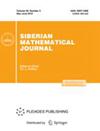论同构重排不变空间类中的同构嵌入
IF 0.7
4区 数学
Q2 MATHEMATICS
引用次数: 0
摘要
众所周知,重排不变空间 \( X \) 中关于 \( [0,1] \)的哈氏系统与某个洛伦兹空间中的成对不相交函数序列的等价性意味着 \( X=L_{2}[0,1] \)直到对数的等价性。我们证明了这一点同样适用于一类均匀互不相等的重排不变空间,并得到了关于这类空间同构嵌入性质的一些结论。特别是,具有 \( 1<p<\infty \)的 \( L_{p}[0,1] \)空间是 \( [0,1] \)上唯一的均匀 \( p \)-异次同构重排不变空间,它具有非难博伊德指数,在半轴 \( (0,\infty) \)上有两个重排不变表示。本文章由计算机程序翻译,如有差异,请以英文原文为准。
On Isomorphic Embeddings in the Class of Disjointly Homogeneous Rearrangement Invariant Spaces
The equivalence of the Haar system in a rearrangement invariant space \( X \) on \( [0,1] \) and a sequence of pairwise disjoint functions in some Lorentz space is known to imply that \( X=L_{2}[0,1] \) up to the equivalence of norms. We show that the same holds for the class of uniform disjointly homogeneous rearrangement invariant spaces and obtain a few consequences for the properties of isomorphic embeddings of such spaces. In particular, the \( L_{p}[0,1] \) space with \( 1<p<\infty \) is the only uniform \( p \)-disjointly homogeneous rearrangement invariant space on \( [0,1] \) with nontrivial Boyd indices which has two rearrangement invariant representations on the half-axis \( (0,\infty) \).
求助全文
通过发布文献求助,成功后即可免费获取论文全文。
去求助
来源期刊
CiteScore
1.00
自引率
20.00%
发文量
88
审稿时长
4-8 weeks
期刊介绍:
Siberian Mathematical Journal is journal published in collaboration with the Sobolev Institute of Mathematics in Novosibirsk. The journal publishes the results of studies in various branches of mathematics.

 求助内容:
求助内容: 应助结果提醒方式:
应助结果提醒方式:


